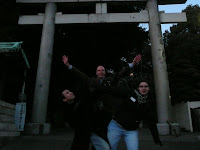





That mean's "It's been a while". And I think it has! A month has it. Are you doing well Oh internet patrons? I'm am quite "genki" (lively/energetic) myself!
So where was I....
LAST TIME ON:
Ama Out of State!!
Matsuri madness!
7-day college student Japan adventure!!
Drama!
Action!
Very Long Bus Rides!!
Ninja!~
So, get down to business.
Setsubun is the Japanese festival on the eve of Spring. Spring in Japan is verrrry Early and starts off, very cold. We were all freezing by the end of it.
I am in a field research class and had the great pleasure of going to a local Jinja "Shinto Shrine" to watch the festivities. We went to the Shiroyama Hachimangu Shrine in Nagoya. We also got an explanation in Japanese from a very important priest at the Shrine. Another perk to being students and gaijin (foreigners) is that we got to watch the ceremony! The ceremony can only been watched by ppl who pay big bucks (7,000 en = <$70). We saw it and got to video tape it for freee!!!!
So the thing about shrines is that they are secluded. In Japanese culture there are many distinctions in space: Ue and shita (high and low), uti and soto (in and out), and ura and omote (back and front). Depending on the distinction in each pair of directions one thing is, the higher its importance and purity. Tatoeba (for example), my head is more important than my feet. Inside is cleaner than outside (the reason why ppl take off their shoes when coming into the house). And the farther back in the office a person is, the longer they've been there and the more power they have.
Shiroyama Hachimangu Jinja is on a mountain! 1st off. Height! In Japanese the world for come is "kuru". Our guide did not talk about coming to to the temple, he said we would raise ourselves "agaru". This made me think of a LOTR (Lord of the Rings) quote, "One does not simple walk into Mordor". "One does not simply "kuru" to Shiroyama~!"
It's also surrounded by some forest! Wrapping it inside and away from the world. After you go up a bunch of steps and through some gates, or up a hill and through some forest you get to the car park. You follow a raised stone path towards the temple, going through the main (and only) door into a higher complex. The buildings here were raised off of the ground and towards the far sides of the complex. There was also an area w/ flowing water where you could wash your hands and mouth to purify yourself before going any farther. The main building which housed the hondana (holiest place in the shrine) was the farthest back. Stone path that began at the main gate, went all the way to the wishing/praying area in front of the shrine. We got to go in and watch the ceremony! There was a lot of bowing, but I learned a lot. I won't describe it here, but I might post a video. The hondana is the place where the kami (god) resides and in there were many little steps leading to a mirror. During the ceremony offerings were giving and blessings were bestowed.
Then came the fun part!!!!
Mame = beans Mamematsuri = bean throwing mayhem!
The special guests who had paid their 70 bucks to get in and the priests starting throwing the lucky on the crowd who gathered outside.
Before I had failed to mention that there was a myraid of ppl waiting outside of the ceremony building with bags, hats, and hands tensed to catch beans. During the festival, people throw baked soybeans from jinja, otera (Buddist temples), and in and out of their houses. While throwing these beans they say "oni wa soto" (demons[or bad things/sickness/misfortune but lit. demons] out!] "fuku wa uti" (good luck in). The priest on the loudspeaker at our Jinja just kept yelling "GYOSHI!" I liked that, I have no translation. Maybe goisho? the sound you make when you do something laborious? Anyhoo I could not catch very well w/ my gloves and my misses were quickly scooped by an agile young miss (and by young I mean probabaly in her 70s).
You could look up the legend behind the beans. I watched a children's show called Chibimaruko-chan that did a great deal towards my understanding, but I'm sure you all know wikipedia.
On Setsubun, you also eat as many beans as you are old. I got my years out of one pack. (They throw packs now, probably for sanitation and easier clean up).
Then you eat a sushi roll called an "eehomaki" (lucky direction maki). Every year there's a new lucky direction. As you face it you eat your whole eehomaki w/o taking it out of your mouth. In one go! Without talking! Twas great fun! Apparently, that tradition started in a bar somewhere and has done wonders for Family Mart's (convience store chain) business.
Picture descrips (out of order):
DBZ Ginyu Force Pose of my partners and Prof. and the main entrance to the shrine
The main gate
Crowd ravenous for beans
Jinja map
Ceremony building with prayer area in front
And a Picture of us w/ the very nice and also Important priest!
Love,
~Ama
Next time on AOS!:
7-day college student Japan adventure!!
Drama!
Action!
Very Long Bus Rides!!
Ninja!~
No comments:
Post a Comment